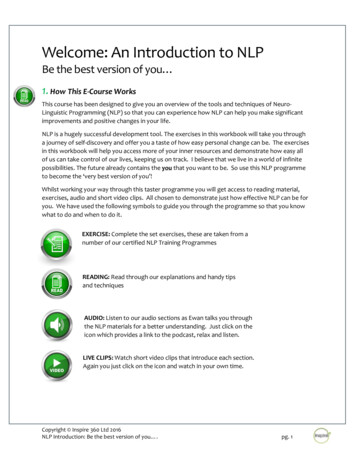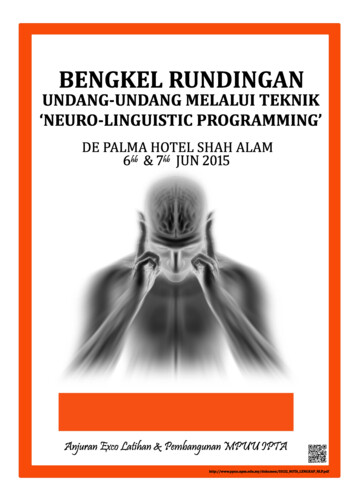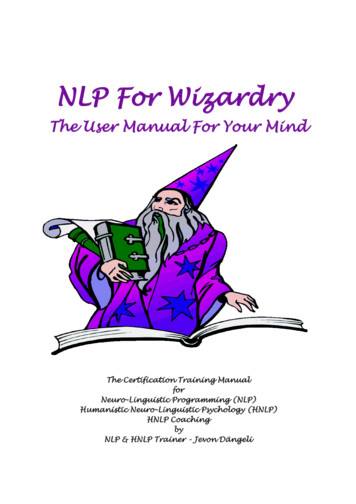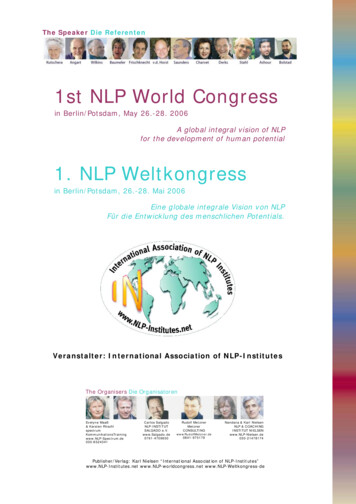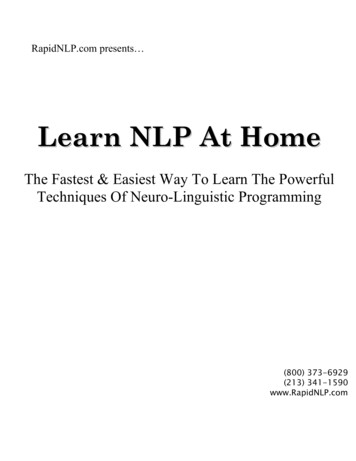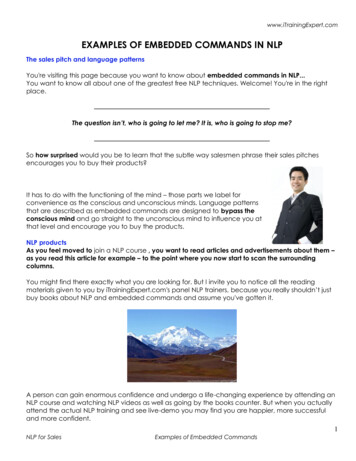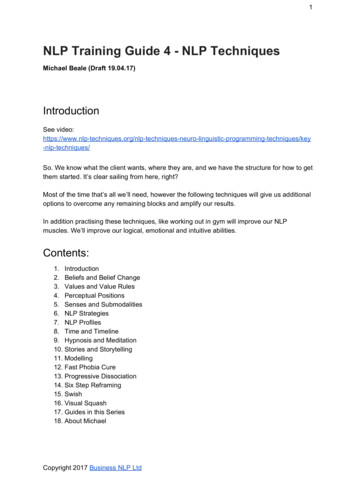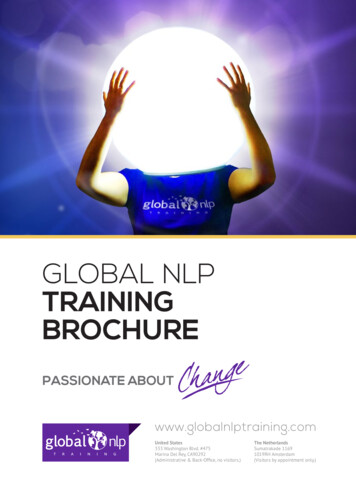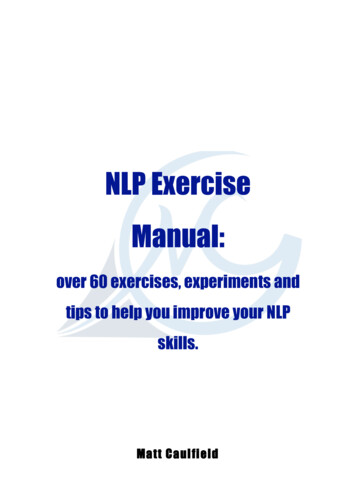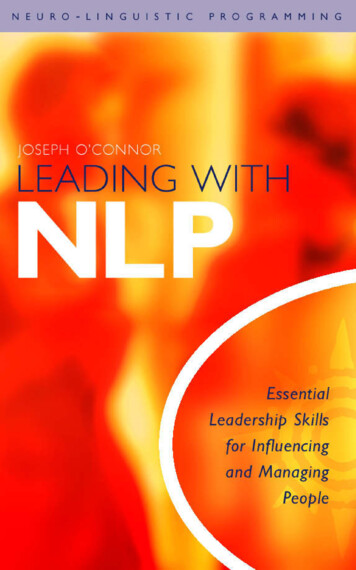
Transcription
L EADINGWITHNLPESSENTIAL LEADERSHIP SKILLS FORINFLUENCING AND MANAGING PEOPLEJoseph O’Connor
PerfectBoundAn e-book from HarperCollins Publishers77-85 Fulham Palace RoadHammersmith, London W6 8JBThorson edition published 2001 ISBN 0-7225-3767-0Copyright (c) Joseph O’ Connor 2001Joseph O’ Connor asserts the moral right to be identified asthe author of this workIllustrations by Jennie DoogeAdobe eBook Reader edition v 1.May 2001ISBN 0-00-713130-5All rights reserved. No part of this publication may be reproduced, stored in a retrieval system, or transmitted, in anyform or by any means, electronic, mechanical, photocopying,recording, or otherwise, without the prior permission of thepublishers.www.fireandwater.com/ebooks
CONTENTSW HAT IS NLP?T HE T HIRTEEN P RESUPPOSITIONSNLP ON THE I NTERNETI NTRODUCTION : T HE L EADER ’ S J OURNEYvviiixixiv1. S TARTING THE J OURNEYfirst stepsvisionsharing your visionleaders in perspective11711172. L EADERSHIP SUBSTANCE , STYLEthe three pillars of leadershipleadership stylethe shadow sidepacing and leadingyour leadership credentialsAND SHADOW2527364045483. V ISION AND VALUESvaluesorganizational vision5555614. O N THE R OADmotivationrewards and penaltiesvalues and integritysignposts to the futurereluctancethe dark side of change71717684878995
5. G UIDES AND R ULES OF THE R OADmentorsunpacking skillsleaders and losersbalancing task and relationshipthe rules of the roadRoman law and common lawlearningsolutions and resolutionsorganizational learning1011011071121171211211271321346. G AMES AND G UARDIANSrules, laws and boundariestrustthe prisoner’s dilemmagames and meta gamesbeliefs and assumptionsthe channel of experience1391391411481521551637. C HANGE AND C HALLENGEsystems thinkingperspectivescause and effectthinking in circlesboundaries and horizonsblame and responsibilitychange and balanceScylla and Charybdisthe edge of chaosthe power law1671691711791811861881921951982018. C ONCLUSION207A PPENDIX : R ESOURCEStraining and consultancyB IBLIOGRAPHYA BOUT THE A UTHOR213213215217
WHAT IS NLP?Neuro-Linguistic programming is the study of our subjectiveexperience; how we create what passes for reality in ourminds. It deals with questions like: How do you do what you do? How is it possible that two people can talk and each have adifferent idea of what was agreed? How come some people are talented and seem more naturally gifted than others? How do we create our feelings of happiness and sadness?NLP also studies brilliance and quality – how outstandingindividuals and organisations get their outstanding results.The methods can be taught to others so they too can get thesame class of results. This is called modelling.NLP has grown by adding practical tools and methods generated by modelling exceptional people. These tools are usedinternationally in sports, business, training, sales, law andeducation.NLP is the systemic study of human communication.NLP has its own presuppositions or beliefs – principles ofaction.
What is NLP?Modelling“NLP is an accelerated learning strategy for the detectionand utilisation of patterns in the world.” John GrinderModelling is the basis of NLP, and is the process that created all the existing NLP techniques. Modelling a skill meansfinding out how someone does a skill so that it can be taughtto others, allowing them to get the same sort of results.Modelling has one basic principle:If one person can do something then it is possible tomodel it and teach it to others.The first NLP model was the Meta Model (modelled fromVirginia Satir and Fritz Perls and refined using ideas fromChomsky’s Transformational Grammar). The second modelwas representational systems and the third was the Milton Model(modelled from Milton Erickson).A model is an edited, distorted and generalised copy of theoriginal and therefore there can never be complete. A modelis not in any sense ‘true’: it can be judged only by whether itworks or doesn’t work. If it works, it allows another person toget the same class of results as the original person fromwhom the model was taken.You can never get exactly the same results as the personyou model, because everyone is different, each learner willassemble the modelled elements in their own unique way.Modelling does not create clones – it gives you the opportunity to go beyond your present limitations.Modelling outstanding people created the basic patternsof NLP. For NLP to survive as a discipline, as a body of knowledge and methodology, it needs to continue to create moremodels from every field – including sport, business, sales,education, consultancy, training, law, relationships, parenting and health. The possibilities are limitless. For example,
What is NLP?you can model: How a person stays in good health or overcomes an illnessExcellent sales skillsLeadership skillsOutstanding athletic achievementsExcellent teachersStrategic thinkingAn NLP model normally consists of: The mental strategies.The beliefs and values.The physiology.External behaviourThe context in which the person being modelled is operating.The full process of modelling involves: elicitationcodingutilisationpropagationdiscovering patterns of experiencedescribing those patterns in terms of NLP distinctions, creating new distinctions or using the distinctions taken fromthe person being modelled exploring ways to use those patterns creating a teaching method to transfer the model to others.
THE THIRTEEN PRESUPPOSITIONSThe thirteen presuppositions are the central principles ofNLP; they are its guiding philosophy, its ‘beliefs’. These principles do not claim to be universal, and you don’t have tobelieve they are true. They are called presuppositions simplybecause you pre-suppose them to be true and then act as ifthey were. You then discover what happens. If you like theresults then continue to act as if they are true. They form aset of ethical principles for life.The Presuppositions of NLP1. People respond to their experience, not to reality itself.We do not know what reality is. Our senses, beliefs, and pastexperience give us a map of the world from which to operate.A map can never be exactly accurate; otherwise it would bethe same as the ground it covers. We do not know the territory, so for us, the map is the territory. Some maps are betterthan others for finding your way around. We navigate life likea ship through a dangerous area of sea; as long as the mapshows the main hazards, we will be fine. When maps arefaulty and do not show the dangers, then we are in danger ofrunning aground. NLP is the art of changing these maps, sowe have greater freedom of action.2. Having a choice is better than not having a choice.Always try to have a map for yourself that gives you the widestand richest number of choices. Act always to increase choice.The more choices you have, the freer you are and the moreinfluence you have.
The Thirteen Presuppositions3. People make the best choice they can at the time.A person always makes the best choice they can, given theirmap of the world. The choice may be self-defeating, bizarreor evil, but for them, it seems the best way forward. Give thema better choice in their map of the world and they will take it.Even better give them a superior map with more choices init.4. People work perfectly.No one is wrong or broken. They are carrying out theirstrategies perfectly, but the strategies may be poorly designedand ineffective. Find out how you and others do what they doso their strategy can be changed to something more usefuland desirable.5. All actions have a purpose.Our actions are not random; we are always trying to achievesomething, although we may not be aware of what that is.6. Every behaviour has a positive intention.All our actions have at least one purpose – to achieve something that we value and benefits us. NLP separates the intention or purpose behind an action from the action itself. Aperson is not their behaviour. When a person has a betterchoice of behaviour that also achieves their positive intention, they will take it.7. The unconscious mind balances the conscious; it is notmalicious.The unconscious is everything that is not in consciousness atthe present moment. It contains all the resources we need tolive in balance.8. The meaning of the communication is not simply what youintend, but also the response you get.This response may be different to the one you wanted. Thereare no failures in communication, only responses and feedback. If you are not getting the result you want, change whatyou are doing. Take responsibility for the communication.
The Thirteen Presuppositions9. We already have all the resources we need, or we can create them.There are no unresourceful people, only unresourcefulstates of mind.10. Mind and body form a system. They are different expressions of the one person.Mind and body interact and mutually influence each other. Itis not possible to make a change in one without the otherbeing affected. When we think differently, our bodieschange. When we act differently we change our thoughts andfeelings.11. We process all information through our senses.Developing your senses so they become more acute gives youbetter information and helps you think more clearly.12. Modelling successful performance leads to excellence.If one person can do something it is possible to model it andteach it to others. In this way everyone can learn to get betterresults in their own way, you do not become a clone of themodel – you learn from them13. If you want to understand – act!The learning is in the doing.
NLP ON THE INTERNETThere’s plenty of NLP on the net – this is a shortened list. Wehave aimed to list main NLP information sites rather thanindividual NLP training organisations.NLP and DHE General Information Server (www.nlp.org)Information and articles, reviews of books and training, andlinks to many training organisations. An excellent site.NLP and Hypnosis (www.nlp.com/flashindex.html)This site is great for NLP and hypnosis, with sample scripts.Run by Advanced Neurodynamics, an NLP training organisation in Honolulu, it also has a section on Huna, the Hawaiianspiritual science.news:alt.psychology.nlpThe NLP newsgroup. Sort the noise from the melody, thepearls from the swine, the flames from the flumes.nlptalkThe main NLP e-mail discussion group. To subscribe, sendan e-mail message with ‘subscribe nlptalk your name’ in themessage body to nlptalk-reserve@egroups.comThe Society of NLP (www.purenlp.com/)Site for the Society of NLP run by John LaValle.Richard Bandler Institute (www.purenlp.com/1stinst.htm)Richard Bandler’s institute of NLP with articles by Richardand his seminar schedule.Robert Dilts home page (www.nlpu.com/)Robert Dilts writings and the home of the NLP University atSanta Cruz, Systemic Solutions International and theDynamic Learning Institute.
NLP on the InternetAnchor Point Magazine (www.nlpanchorpoint.com/)Excellent monthly magazine with developments and practical applications in NLP and related technologiesThe NLP Information Center (www.nlpinfo.com/)Another good general site with many links. It also sells NLPbooks.The NLP FAQ (www.rain.org/ da5e/nlpfaq.html)Questions and answers about NLP.NLP World (www.unil.ch/angl/docs/nlpworld/)Well produced and engaging magazine published threetimes a year – the intercultural journal on the theory andpractice of NLP.Merl’s lp home.htm)A good reference site. Nearly 100 NLP book reviews, plus listsof NLP trainers and organisations worldwide.Honest Abe’s l)Andy Bradbury’s detailed NLP book reviews, frequentlyasked questions (FAQs) and useful links.International Association for the Study of Health (IASH)(www.iash.org/)IASH is allied to the health certification trainings. Manyresources for NLP applied to good health and well being.IDEA Seminars, Inc. (www.idea-seminars.com/)Training center NLP run by Rex and Caroline Sykes.Seminars provides high quality NLP training for everyone.Mastery InSight Institute of NLP(www.altfeld.com/mastery/)100 pages of information on trainings, also the logs recordedduring scheduled chats on NLP on IRC.The English Association of NLP (ANLP) (www.anlp.org/)Ten years old this year and still standing.
NLP on the InternetDirectory of NLP and Time Line Therapy Resources(easysearch.hypermart.net/nlp.htm)A resource list of trainers, educators, health professionals,consultants, therapists, counselors, etc who use NLP and/orTime Line Therapy as part of their practice.Brian Van der Horst - NLP website(hammer.prohosting.com/ brianvdh/)A good website of NLP resources by my friend Brian.Neurosemantics Website (www.neurosemantics.com/)Website of articles and resources on neurosemantics andNLP.Active Choice NLP (www.acnlp.no/)An NLP training institute in Norway.NLP-Platform (nlp-platform.com/nlp/)NLP site in Belgium with many links and resources
INTRODUCTION:THE LEADER’S JOURNEYTwo people died in the same week in August 1997, PrincessDiana in Paris and Mother Teresa in Calcutta. They couldhardly have been more different on the surface. PrincessDiana was rich, famous, beautiful and controversial. MotherTeresa was an elderly Albanian nun who slept on a hard bedand worked with the poor and sick on the streets of Calcutta.Yet both touched people’s hearts; they were loved and respected as well as being international figures. They wereleaders. When they died, people who had never met themmourned them. Why?Because both were not perfect icons but real people withhuman frailties that others could identify with. They werelike us, yet they expressed something of the best in us –something of what we are and could be. These two peoplewere in the public eye, like many others we regard as leaders– politicians, artists, musicians and businessmen – but leadership is more than a job description. Leadership is a way ofacting and a way of being that we all can have, not something‘out there’, something for other, famous people. At everylevel leaders have the ability to help people, express theirhopes and carry their fears. I would like this book to demystify leadership, taking it down from its high pedestal andmaking it a natural part of life.In the past, leaders were the rich, the powerful and thefamous, great kings, warlords, scientists and thinkers, outstanding artists or craftsmen, or giants of commerce.Literature and history hold them up as examples and itseems we can only aspire to be pale copies. Over the twentieth century there has been a profound democratization in
Leading with NLPalmost every aspect of human life, except leadership. Atfirst sight this seems to make sense – after all, we can’t all beleaders, can we? No. Not if we continue to accept a narrowdefinition of leadership based on power, high profile andwide authority.Let us reclaim leadership to its original meaning: taking apath or going on a journey. Leadership is the journey itself,the activity, not the destination – a stimulating and fulfillingjourney where planning and preparation are also importantand enjoyable in their own right.I see leadership skills as the most important resource wehave to develop to deal with the capricious times in which welive. That we live in times of rapid change is a truism – wehave to adapt to the sort of breakneck changes in one lifetime that previously would have taken generations. In theworld of business, markets and strategies change fast. We areon a high-technology carousel that never seems to slowdown. The carousel spins with bewildering speed as we striveto deal with the present and shape the future but withsystems and organizations designed to cope with the past.We have more information, but knowledge – informationthat matters and makes a difference – is as hard as ever toacquire. We take a sieve to the torrent of information thatdrenches us every day and hope to catch something of value.How can we pin down leadership, one of the most talkedabout and written about subjects in business? Is it charisma? Influence? Inspiration? Stewardship? Yes. It may be. Because thereason you set out on your journey, your chosen destination,who you travel with and how you travel may all vary. That’swhat is so infuriating and valuable about leadership. There aremany roads, many destinations and many ways to travel.So why learn to be a leader? To be involved in what reallymatters to you. To be able to do what inspires and movesyou. To have companions on your journey. In any area whereyou want more influence you must be a leader.Leadership has a paradox at its centre – while greatlyprized, you cannot grab it for yourself directly. It is a giftwhich can only be given by others. Being a leader has no
Introductionmeaning without others who choose to travel with you. Aleader all alone is like the sound of one hand clapping.So this book represents a journey in three senses. First ithas travellers’ tales from leaders on their path. What was itlike for them? What did they find? Where are the pitfalls andthe dragons on the path? What essential travel equipment dowe need? These tales come from all over the world. Secondly,this book is a practical tour guide for you to prepare in yourimagination what you want to do in reality. Thirdly, this bookis itself a journey. I have a plan and a vision of what it will beabout and what it will do. I have my map, but the writing hasa momentum and direction of its own and right now I do notknow exactly what route we will take. I know where we needto arrive, but there are many fascinating sights to see, soundsto hear and places to explore on the way. We do not knowwhat exactly we shall find in them and there may be someunscheduled stops on the way.This is a personal view of leadership. For me, three areas ofleadership stand out: self-development, influencing andcommunication skills, and systemic thinking.First, being a leader means developing yourself. You needto be strong and resourceful in order to make the journey.As you become a leader, you find resources in yourself youdid not know you had. You become more yourself, because aleader’s greatest influence comes from who they are, whatthey do and the example they set. Secondly, a leader inspiresothers to join them on the road, so leadership involves communication and influencing skills. Otherwise you are a lonetraveller, not a leader. Thirdly, a leader must look towardstheir destination, as well as paying attention to where theyhave been and where they are. Without such a road map,however strong they may be and however many companionsthey may have, they may get lost down a cul-de-sac or stuckin a swamp. A leader needs to understand the system theyare part of, to see beyond the obvious, beyond the immediate situation, to sense how events connect to deeperpatterns. So leadership is a combination of who you are, the
Leading with NLPskills and talents you have, and your understanding of thesituation or the context you are in. While these elementsare universal, you will put the pieces together in a wayunique to you.You can use this book in any area of your life whereyou want the benefits of being a leader. I will concentrate,however, on business examples because leadership is so important in business and business holds so many opportunities to be a leader.Leadership is no easy ‘faddish’ package that you can handout as part of a corporate restructure to solve all your problems. It needs work; you need to develop the ability torespond to challenge as well as deal with the specific challenges that arise in the course of your business. I want tolook at leadership from the inside as well as the outside.What are the most useful ways to think about managing abusiness? What skills are needed? Leadership holds some answers to these questions.The Management Agenda, a report published by the RoffeyPark Management Institute in 1998, contained the repliesof a sample of managers to questions on work issues. Manywere critical of senior managers for lacking leadership. Atthe same time, they said that they themselves were expected to be leaders, yet they had no training on what thisinvolved or how to adjust to this new identity. There seemsto be a need for leadership in business and at the sametime a vacuum about what this means in practice and howto make the change.Leadership is part of, and the result of, the great changesin management practice in the last 20 years. It replaces theold ‘command and control’ model of running an organization. ‘Command and control’, based on a military mentality,was appropriate in a different social climate and a stablebusiness environment. Now this stability has gone, a casualtyof a frenetic pace of change, new values of self-esteem andindividual responsibility and a business culture that valuesemployability above employment. In most business organizations, particularly in the Western world, we just do not
Introductionobey orders any more – at least not without good reason. Butleaders are still needed, both to guide the organization andto develop others as leaders.Leadership is not a quality that can be rationed or controlled; rather, it is based on purpose, vision and values:purpose to set the destination, vision to see where you aregoing and values to guide you on the way towards a successful and sustainable future.When I think of how organizational leadership could be,I think of the flight of a flock of birds. I watched a flock ofstarlings swoop over the horse chestnut trees close to whereI live a few days ago. The birds moved together in beautifuland intricate patterns, moving away and then sweepingback, describing a sort of figure of eight, but no pass wasquite like any other. How did they do it? There were one ormore birds at the front, but they were not issuing orders tothe others, telling them exactly how to move so they allstayed together. The leader (if the one at the front was theleader) was different every time they passed over my head.Yet somehow they not only flew together, but also kept information. They could adjust in a split second to keep thepattern, but the pattern was never identical from momentto moment. How did they stay together in that marvellousformation like liquid rolling through the air? How do starlings organize themselves, keeping their individuality andyet being part of a wider coherent group? There seems to bean intelligence that emerges from the group, coming fromthe intelligence of each member, yet larger than that possessed by any individual.Leaders face the organizational challenge of creating thecontext where that larger intelligence can emerge withoutdiminishing the individuals in any way. The more the individuals use their own intelligence to the full for themselves,the smarter the group becomes. This is the puzzle and thechallenge of how individual and organizational learningwork together. So, here is the secret of organizational leadership. How do you develop each person as a leader and getthem all to fly in formation?
Leading with NLPWhat resources do we have to help us achieve this? NeuroLinguistic Programming (NLP) is a broad field that began inthe mid-1970s modelling excellent communicators – findingout how they did what they did so well. NLP models how wedo what we do. In essence it studies the structure of subjective experience – how we create our own unique internalworld from what we see, hear and feel, and how in turn ourmental world shapes what we allow ourselves to see, hear andfeel. NLP has modelled top people in every field – managers,salespeople, teachers and trainers – in order to teach othersthese skills, so they do not have to reinvent the wheel. It hasa wealth of material from leaders – how they think and whatthey believe.NLP is made up of three parts: ‘Neuro’ is our neurology – how we think and feel. ‘Linguistic’ is the language part – what we say, how wesay it and how we are influenced by what we hear. ‘Programming’ is how we act to achieve our results.NLP helps us to understand what leaders do and how theyget their results, so you can take those parts that suit you andthat fit in with your values and beliefs. You don’t copy them,you learn from them to achieve your goals. Whatever skills youhave, NLP can help you make more of them. It also givespractical ways of developing those skills, not an intellectualappreciation of how nice the skills would be to have or howgreat they are in other people. NLP is a valuable guide onthe leader’s journey.Our second guide on the journey is systemic thinking –thinking in terms of feedback and relationships, seeing patterns, not isolated events. Leaders have to understand thesystem they are in, and systems do not operate logically,small changes can produce large effects and these need notoccur in the same place or at the same time as the cause.Straight-line cause and effect thinking does not work in business organizations, because they are complex systems. Theremay be many effects from just one change. Also, what you do
Introductionto solve a problem may actually perpetuate it, or even makeit worse in the long run. But when you think systemically, youthink past the obvious to the dynamic patterns that generatea problem.A third resource is the insights from the discipline of complexity science. Complexity is the application of systemsthinking to complex systems (like business organizations)that behave in complicated ways. Recent research has givenus some fascinating insights into complex systems that wecan tentatively apply to business. For example, a few simplerules can generate very complex behaviour. What are therules that hold the flock of birds together and how mightthose rules map over into creating a prosperous andsuccessful organization? We can make some interesting speculations. Also, there seems to be an optimum point for abusiness – between the indolence of too much deadeningprocedure and the chaos of too much change. Too muchorder and the business becomes inflexible, too rigid to reactquickly enough to the demands of the external market orthe demands of the people within it. Too much freedom andthe organization does not work either: rules change tooquickly and people become disoriented and confused. People can learn best at the delicately poised point of balancebetween the two extremes. How can an organization getto this ‘edge of chaos’ with enough creativity to adaptto change, but within a structure stable enough to operateeffectively? Getting to this edge is one of the main tasks of anorganizational leader.Finally, complex systems are not predictable. In theory theymay be, but as the old saying goes, ‘In theory there shouldn’tbe a difference between theory and practice, but in practice,there always is.’ Complete control is impossible, and even if itwere, it would be the kiss of death. There is no book, methodor consultant that can tell you how to push the river (althoughmany claim credit that it is their pushing that causes the riverto move). But that does not mean you are helpless. Quite theopposite. It is a tremendous relief to admit that you cannotpredict and therefore cannot entirely control a complex
Leading with NLPorganization. You can give up trying. Now you can start to seehow the organization really works and allow it to organize itself in the best way. This is a leader’s work.NLP explores how people think and the results they get.Complexity and systems thinking explore the organizationsthey create as they work together. These ideas are fascinatingand practical – which is why I write about them. Togetherthey are the basis of our map.Organizations are fond of saying that the quality of thepeople who work in them gives them their competitive edge.At the risk of being heretical, I doubt this very much. Everyorganization has excellent people of high quality. The leadersmake the difference. They determine the quality of theexperience of working in that business, they weave thatindefinable, yet very important fabric – the organizationalculture. At the same time, I believe everyone in an organization can be a leader in some way. I hope this book is a steptowards making this possible and real.How to Use This BookMy goal in this book is to weave the three strands of leadershipinto a thread to guide you through the twists and turns of theleader’s path. There are suggestions and exercises to developyourself as a leader, to influence others in any situation whereyou are called on to lead, and to learn systemic thinking skillsand apply them in a professional business context.There are seven sections: The first begins the journey. It starts with your vision –why be a leader? What does it mean? The second section deals with different types of leadersand styles of leadership, explaining how when, whereand why they are useful. The third section starts to move away from the presentand looks at vision, values and purpose, both organizational and individual.
Introduction The fourth looks at motivation and how to build it, alsothe dark side of leadership, the difficulties and obstacles. The fifth deals with resources on the journey — themaps, guides and rules of the road. The sixth looks at the guardians you will meet on the wayand how to overcome them, how to build trust and betrust-worthy. The guardians are not only external difficulties such asresistance from other people and organizational inertia,but also your own internal resistances and blocks. The seventh section is about the skills and responsibilities you face as a leader and how you might get abusiness to fly in formation. The last section is about passing on the skills you havelearned to others through coaching and mentoring. Italso has a summary of the principles of leadership. There is also a resource section at the end with abibliography.Use this book to form your leadership skills, to develop yourself and others. Use it to stimulate ideas for dealing withman
“NLP is an accelerated learning strategy for the detection and utilisation of patterns in the world.” John Grinder Modelling is the basis of NLP, and is the process that cre-ated all the existing NLP techniques. Modelling a skill means find

